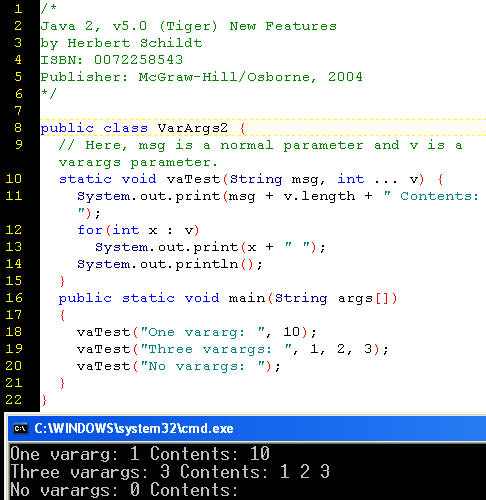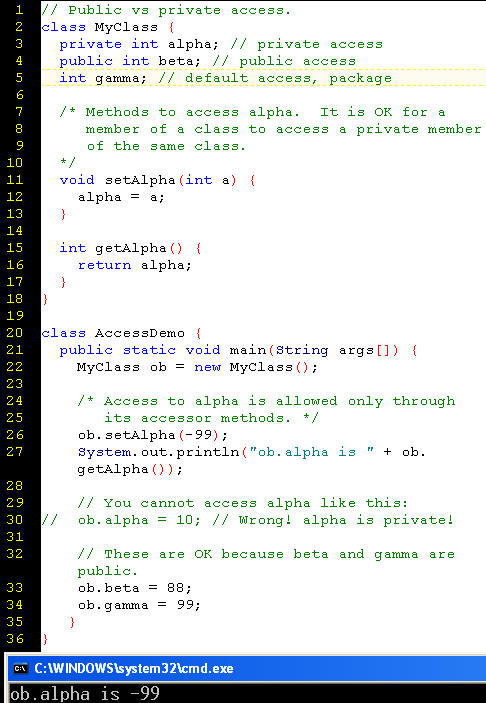
| 17-OCT-2005 This lecture covers the reading in Module 6: A Closer Look at Methods and Classes |
A Closer Look at Methods and Classes |

What can be made private? How about an entire class? No. A private class would allow no access and would be useless. There are only two access levels for a class: public or the default, which is accessible within the package.
If you declare a class to be public:
| Class Specifier | within the package | outside the package |
|---|---|---|
public |
X | X |
default (undeclared) |
X |
In Week 8, we will learn more about packages.
For now, let's focus on access levels to class members.
http://java.sun.com/docs/books/tutorial/java/javaOO/accesscontrol.html
Encapsulation: One of the benefits of classes is that classes can protect their member variables and methods from access by other objects. Why is this important? Well, consider this. You're writing a class that represents a query on a database that contains all kinds of secret information, say employee records or income statements for your startup company.
Certain information and queries contained in the class, the ones supported by the publicly accessible methods and variables in your query object, are OK for the consumption of any other object in the system. Other queries contained in the class support the operation of the class--such as an "internal engine"--but should not be used by objects of another type. You want to protect secret information from, say, programmers in other departments in your company. Or, you want to keep your program stable while third parties make calls into your code using application programming interfaces (API calls) you expose.
In Java, you can use access specifiers to protect both class variables and methods. You use the access specifier as part of your declaration.
The Java language supports four distinct access levels for member variables and methods: private, protected, public, and, if left unspecified, package.The following chart shows the access level permitted by each specifier.
Class Member Specifier class subclass package world privateX protectedX X
limitationX publicX X X X packageX X The class column indicates whether the class itself has access to the member defined by the access specifier.
A class always has access to its own members.
The subclass column indicates whether subclasses of the class (regardless of which package they are in) have access to the member.
The package column indicates whether classes in the same package as the class (regardless of their parentage) have access to the member.
The world column indicates whether all classes have access to the member.
The easiest access specifier is
public. Any class, in any package, has access to a class's public members. Declare public members only if such access cannot produce undesirable results if an outsider uses them. There are no personal or family secrets here; this is for stuff you don't mind anybody else knowing.To declare a public member, use the keyword
public. For example,package Greek; public class Alpha { public int iampublic; public void publicMethod() { System.out.println("publicMethod"); } }Let's rewrite our
Betaclass one more time and put it in a different package thanAlphaand make sure that it is completely unrelated to (not a subclass of)Alpha:package Roman; import Greek.*; class Beta { void accessMethod() { Alpha a = new Alpha(); a.iampublic = 10; // legal a.publicMethod(); // legal } }As you can see from the above code snippet,
Betacan legally inspect and modify theiampublicvariable in theAlphaclass and can legally invokepublicMethod.
The most restrictive access level is private. A private member is accessible only to the class in which it is defined. Use this access to declare members that should only be used by the class. This includes variables that contain information that if accessed by an outsider could put the object in an inconsistent state, or methods that, if invoked by an outsider, could jeopardize the state of the object or the program in which it's running. Private members are like secrets you never tell anybody.
To declare a private member, use the
privatekeyword in its declaration. The following class contains one private member variable and one private method:class Alpha { private int iamprivate; private void privateMethod() { System.out.println("privateMethod"); } }Objects of type
Alphacan inspect or modify theiamprivatevariable and can invokeprivateMethod, but objects of other types cannot.
For example, theBetaclass defined here:class Beta { void accessMethod() { Alpha a = new Alpha(); a.iamprivate = 10; // illegal a.privateMethod(); // illegal } }cannot access the
iamprivatevariable or invokeprivateMethodon an object of typeAlphabecauseBetais not of typeAlpha.When one of your classes is attempting to access a member variable to which it does not have access, the compiler prints an error message similar to the following and refuses to compile your program:
Beta.java:9: Variable iamprivate in class Alpha not accessible from class Beta. a.iamprivate = 10; // illegal ^ 1 errorAlso, if your program is attempting to access a method to which it does not have access, you will see a compiler error like this:
Beta.java:12: No method matching privateMethod() found in class Alpha. a.privateMethod(); // illegal 1 errorNew Java programmers might ask if one
Alphaobject can access the private members of anotherAlphaobject. This is illustrated by the following example. Suppose theAlphaclass contained an instance method that compared the currentAlphaobject (this) to another object based on theiriamprivatevariables:class Alpha { private int iamprivate; boolean isEqualTo(Alpha anotherAlpha) { if (this.iamprivate == anotherAlpha.iamprivate) return true; else return false; } }This is perfectly legal. Objects of the same type have access to one another's private members. This is because access restrictions apply at the class or type level (all instances of a class) rather than at the object level (this particular instance of a class).
Note:
thisis a Java language keyword that refers to the current object. For more information about how to usethissee The Method Body.
The package access level is what you get if you don't explicitly set a member's access to one of the other levels.
The package access level allows classes in the same package as your class to access the members.
This level of access assumes that classes in the same package are trusted friends.
The existence of inheritance outside the package does not grant access: subclasses that are not in the package do not have access.
This level of trust is like that which you extend to your closest friends but wouldn't trust even to your family.For example, this version of the
Alphaclass declares a single package-access member variable and a single package-access method.Alphalives in theGreekpackage:package Greek; class Alpha { int iampackage; void packageMethod() { System.out.println("packageMethod"); } }The
Alphaclass has access both toiampackageandpackageMethod. In addition, all the classes declared within the same package as Alpha also have access toiampackageandpackageMethod. Suppose that bothAlphaandBetawere declared as part of theGreekpackage:package Greek; class Beta { void accessMethod() { Alpha a = new Alpha(); a.iampackage = 10; // legal a.packageMethod(); // legal } }
Betacan legally accessiampackageandpackageMethodas shown.
Protected access means the members of all the following have access:
- the class itself
- subclasses
- all classes in the same package
Use the protected access level when it's appropriate for a class's subclasses to have access to the member, but not unrelated classes.
Protected members are like family secrets--you don't mind if the whole family knows, and even a few trusted friends, but you hide your family secrets from outsiders in the world at large.To declare a protected member, use the keyword
protected. First, let's look at how the protected specifier affects access for classes in the same package. Consider this version of theAlphaclass, which is now declared to be within a package namedGreek,and which has one protected member variable and one protected method declared in it:package Greek; public class Alpha { protected int iamprotected; protected void protectedMethod() { System.out.println("protectedMethod"); } }Now, suppose that the class
Gammawas also declared to be a member of theGreekpackage (and is not a subclass ofAlpha).
TheGammaclass can legally access anAlphaobject'siamprotectedmember variable and can legally invoke itsprotectedMethod:package Greek; class Gamma { void accessMethod() { Alpha a = new Alpha(); a.iamprotected = 10; // legal a.protectedMethod(); // legal } }That's pretty straightforward. Now, let's investigate how the
protectedspecifier affects access for subclasses ofAlpha.Let's introduce a new class,
Delta, that derives fromAlphabut lives in a different package--Latin. TheDeltaclass can access bothiamprotectedandprotectedMethod, but only on objects of typeDeltaor its subclasses. TheDeltaclass cannot accessiamprotectedorprotectedMethodon objects of typeAlpha.The
Deltaclass has access to whatDeltainherits as a subclass ofAlpha, butAlphaitself is protected from encroachment by its subclass in a foreign package.in the following code sample attempts to access the
accessMethodiamprotectedmember variable on an object of typeAlpha, which is illegal, and on an object of typeDelta, which is legal.
Similarly,accessMethodattempts to invoke anAlphaobject'sprotectedMethod,which is also illegal:package Latin; import Greek.*; class Delta extends Alpha { void accessMethod(Alpha a, Delta d) { a.iamprotected = 10; // illegal d.iamprotected = 10; // legal a.protectedMethod(); // illegal d.protectedMethod(); // legal } }If a class is both a subclass of and in the same package as the class with the protected member, then the class has access to the protected member.
How does the ok method (lines 33-37) work?
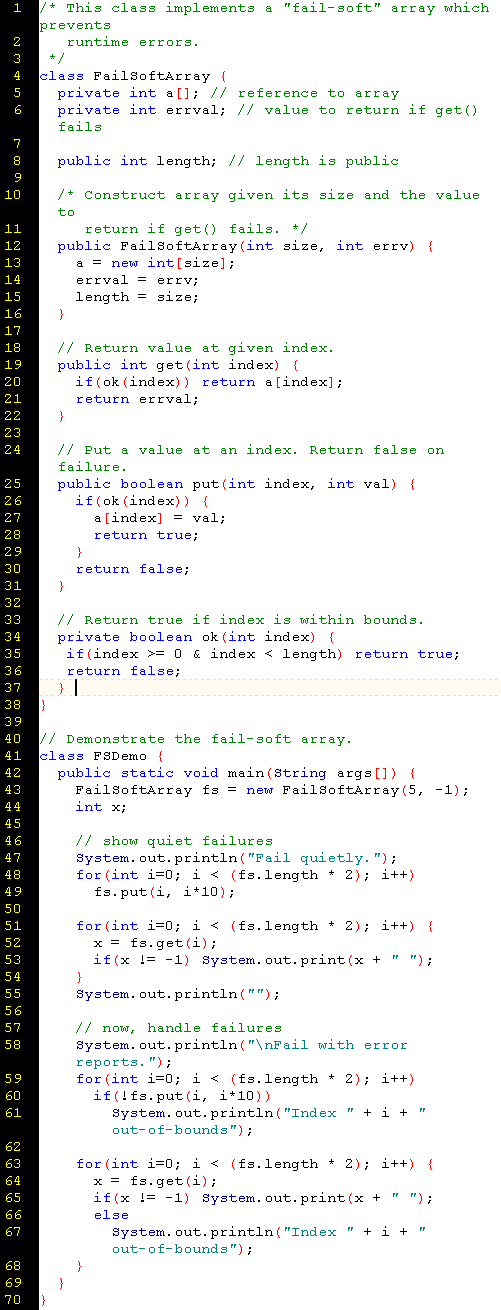
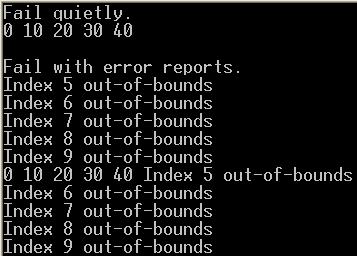
Which lines instantiate objects?
In line 33, is ob2 a formal parameter?
What makes it possible for ob.a to sometimes
have a different value than a?
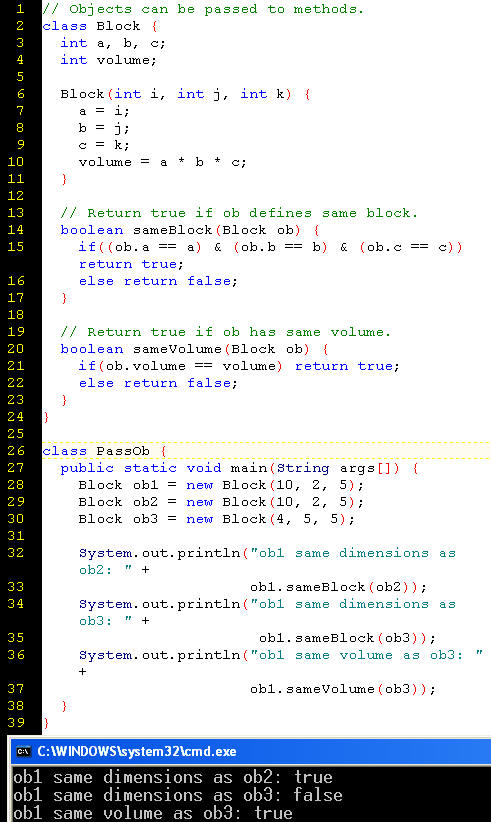
Primitive types can be referenced by variables that have their own copy. The runtime arguments a and b remain unaffected by value changes within the noChange method.
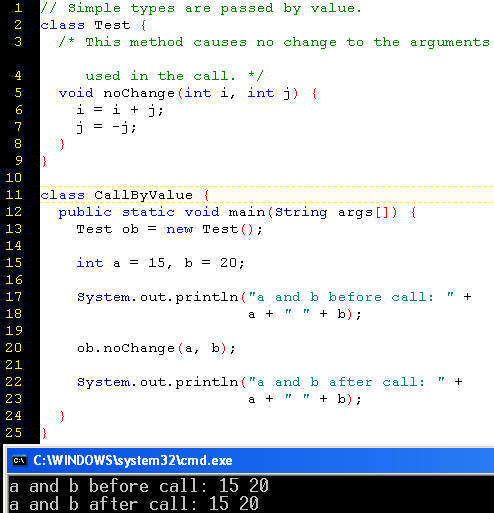
Object types can be reference by variables that point to the object in memory. What enables the change method to change values?
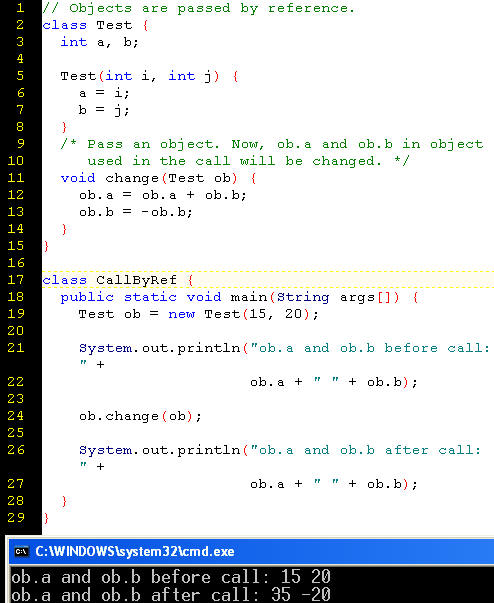
Does the getErrorMsg method return a primitive?
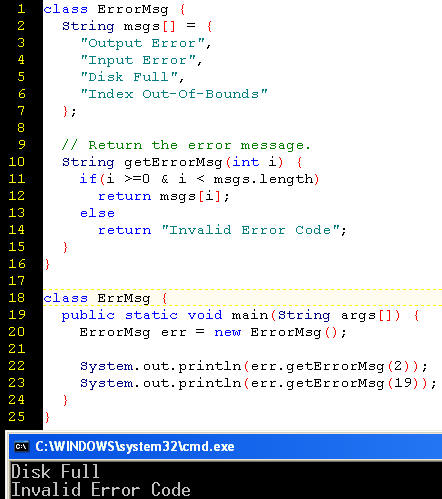
This version uses a different mechanism to print out a message. What are declared in lines 3 and 4?
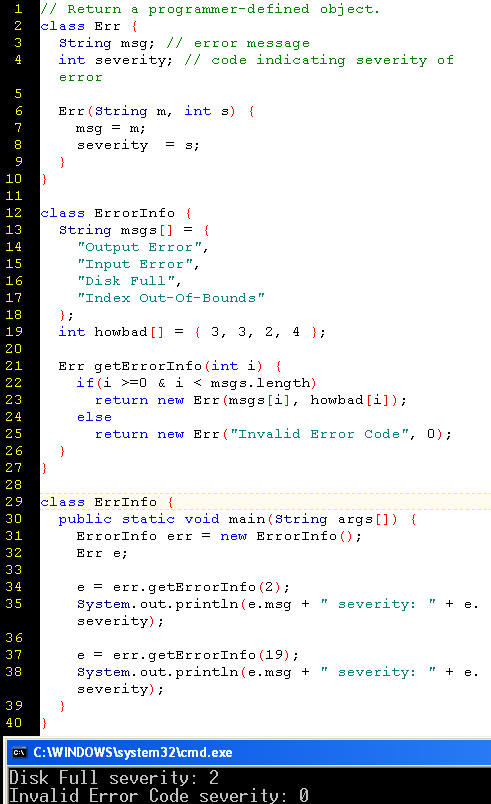
Methods can be overloaded if each one has a parameter list with a unique signature:
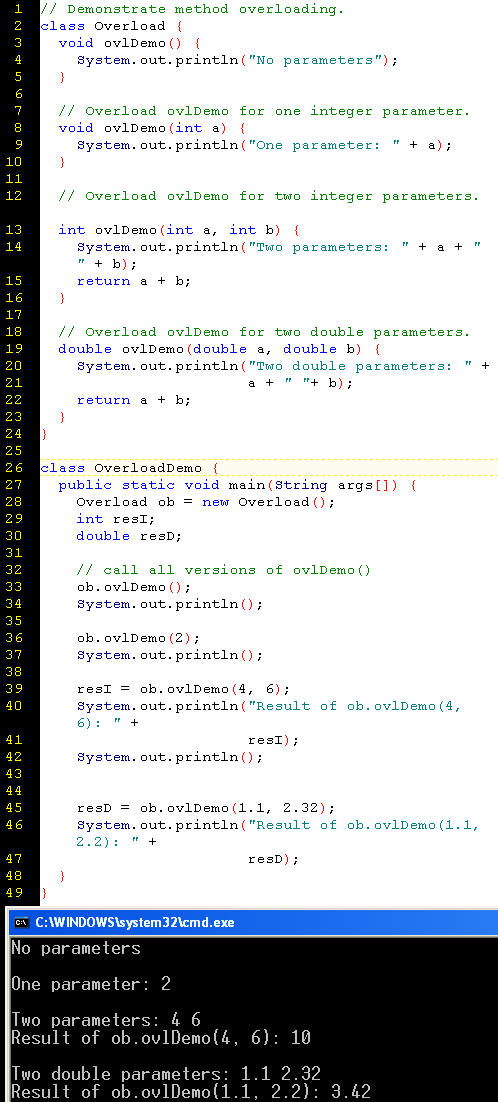
The unique constructor rule applies, as well, to constructors.
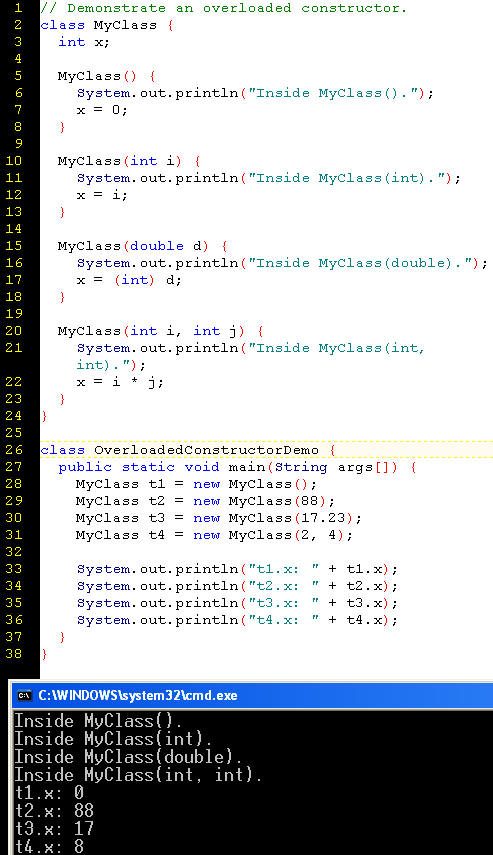
Just as a method can take an object argument at runtime, so can a constructor.

Does this application have an overloaded constructor?
The queue is a first-in-first-out (FIFO) data structure. Which access specifiers
protect its data integrity?
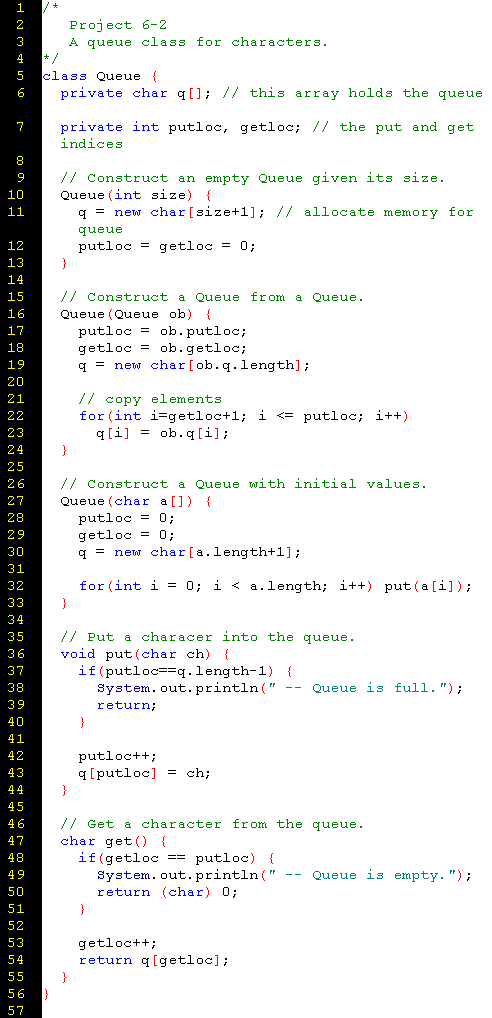

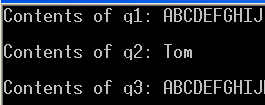
Recursion means that a method calls itself. Which line makes the recursive call?
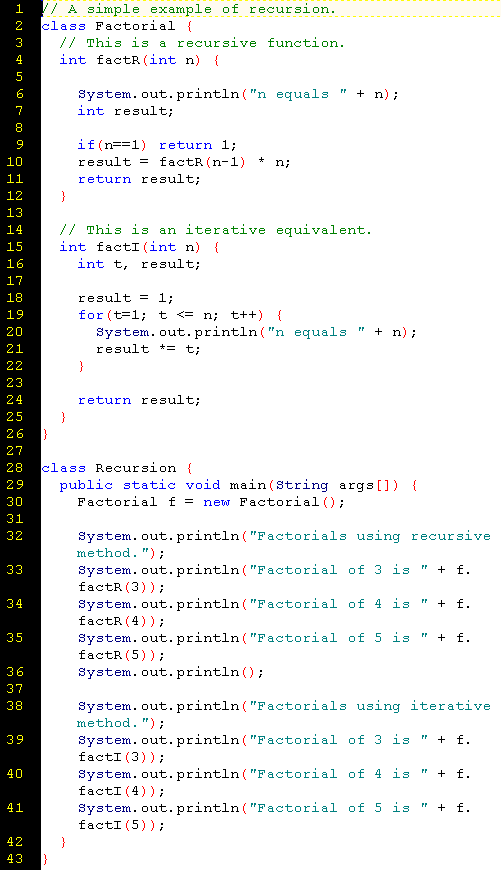
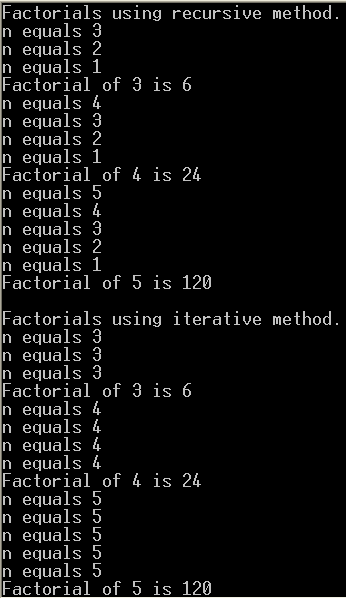
If a class member is static, it stands its own ground, if you will,
available before and independently of object creation.
Insofar as a static member is globally shared among all objects of a given type,
that static member is unchanging.
However, the value of a static member can change--but whatever its current
value, it is the unchanging between the objects of the type.
To reference a static member, you can do either of the following:
Are both of these options valid for class members that are not static?
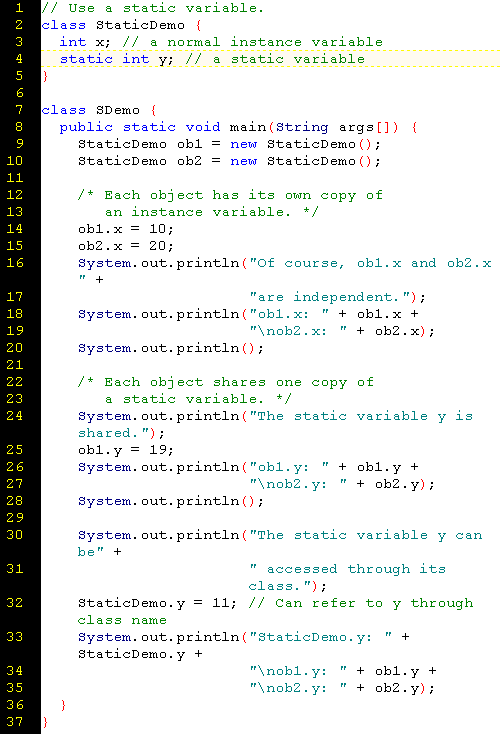
Here's a static method. What would we have to do if System.out.println() were not static?

To make a set of items available independent of object instantiate, put them in a static block. Which lines define the scope of the static block?
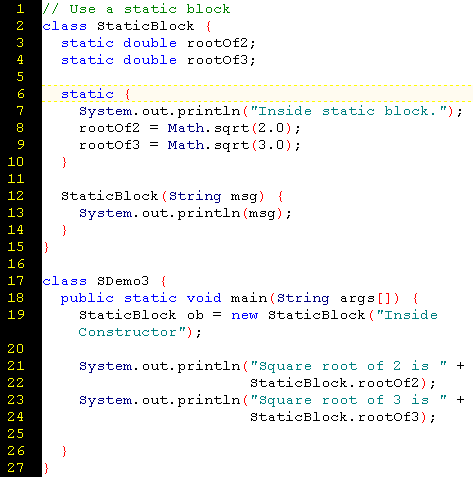
How does the Quicksort algorithm work? Why is it quicker than the Bubble
sort?
Why is qs private?
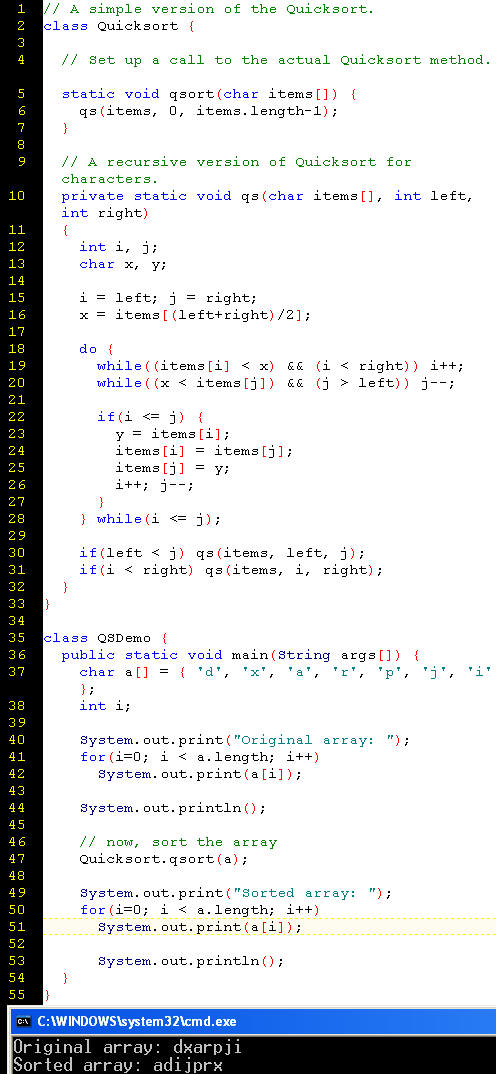
A new feature of J2SE5 is the varargs
method, which is flexible in the number of arguments passed to a method.
What is the data type of v?
How does this example compare to our discussion of an overloaded method
requiring a unique signature?
In the signature for the vaTest method, can
the variable-length argument precede the String argument?
